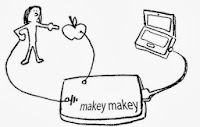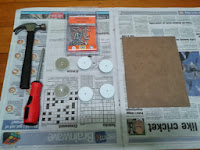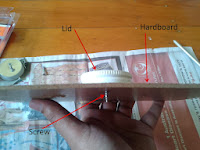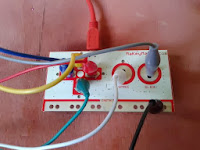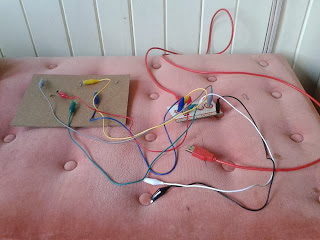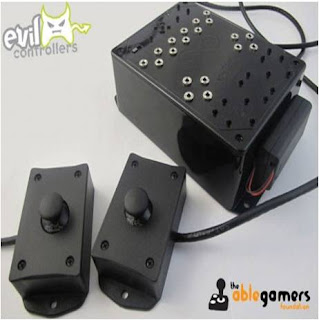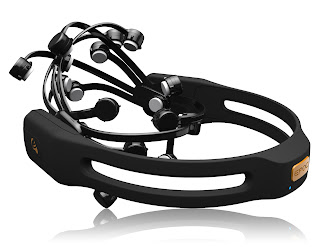It was time to check again with TADQ. So, I packed up
my Makey-Makey kit and 'home-made' basic game controller and went there. I was
really glad that my application has been processed and now I am ready to
volunteer for TADQ! I was lucky enough to meet their Occupational Therapist
(OT) and a technician who is a volunteer. Firstly, I demonstrated my game
controller by playing a car racing game from my laptop. They liked the idea of
using beer lids and low cost material and also seemed to be highly interested
in Makey-Makey kit. This controller required very low pressure to activate the
buttons which was a favourable factor in developing devices for the people with
motor disabilities (MDs).
The OT suggested possible avenues to explore in
improving communications of the disabled people.
- A controller to navigate a media/DVD player without using a keyguard for a keyboard. Keyguard is a keyboard shaped board with holes for each key which supports a person with low motor skills to control his/her finger movements better with high accuracy. However, these keyguards are highly costly and need to be custom made for each individual which can incur a higher cost. Both OT and technician suggested that my game controller can be customized to achieve this.
- Word prediction software for computers, tablets and phones. Aim of this is to aid people with motor disabilities to type faster and accurately. Currently, the available software is not much accurate in achieving this and they are expensive to purchase.
- An
application and a device to turn pages in an iBook for a person who is
using a tablet PC. Some people like to read eBooks as they cannot turn
pages in physical books. However, using keyboard or touchpad is equally
tiresome for such a person. Therefore more simple solution is required to
achieve this. There is a solution for this from Spectronics called J-Pad
that
works with iPad, iPod Touch and iPhone using Bluetooth connectivity
(http://www.spectronicsinoz.com/product/j-pad-wireless-joystick-for-ipad).
However, this is highly expensive to be afforded by a single person
($459.00)
like many assistive devices in the market. Therefore, OT suggested
that
using Makey-Makey will be a great idea instead of using these types
of
high end devices.
 | |
| A keyguard for a QWERTY keyboard Source: http://www.dyslexic.com |
- Compatibility with Apple Mac and iPad. They suggested that Apple has more accessibility features than some other platforms. However, it is still difficult for a person with MDs to access them using touch based interfaces or keyboard. Therefore, new and simple solutions are required like the controller I have proposed. They noted that this can be a highly fruitful research avenue.
- There are number of software tools which can assist the people with MDs in the level of opening and closing a particular application especially on tablet PCs. However, there are limited number of tools to assist them in operating inside a given software application. Developing software to assist this functionality can be highly useful.
There are certain issues and factors to be considered when
developing these technologies. The OT noted that spreading of saliva on the
controller by the disabled person can be both hygienic and technical issue.
This affects specially for Makey-Makey as it is based on conductive materials.
Saliva can cause short circuiting and affect the functionality of the
controller. She also said that dribbling of fingers is a main issue for people
with MDs. While some people need to use low pressure keys, some have issues
with shifting from one position to another or with repeated presses which
cannot be solved by disabling repeat key function in the PC. Layout of the
buttons is also an important aspect since different persons have different
orientations. My game controller scored '0' in the aspect of
flexibility in placement of buttons as they are fixed to the board using screws!
It will be great if we can use as minimum number of
wires as possible to reduce the bulky and messy nature of the device. Wireless
connectivity is an ideal way to achieve this target. My set-up included number
of wires from controller to the circuit. However, the technician pointed out
that it is possible to use a single container for all wires and hide them in a
package so the person who uses it do not get confused and not be troubled with
wires hanging out! The OT stated that it is wise to start with single or dual
button setup if we pursue with the games. The game also should be simple with
minimum number of tasks where the person can enjoy without much effort. These
games should be customized to accommodate different intellectual levels of the
people with disabilities.
Their technician noted that concerning on the
hardware aspects is as equally important as the software when developing technologies
for the disabled. Poorly designed controller can ruin the value of a software application
that can be highly useful for a disabled person. As an example carefully
designed media player will be useless if the person cannot control it using the
standard keyboard. He also seemed to be interested in a case where a client
requested to build a tool to control a DVD player on Apple Mac. He stated that
this tool will be developed as an 'add-on' to the Mac instead of replacing the
keyboard. Makey-Makey seemed to be a promising starting point for this project.
I also requested them to count me in for this project!
The bottom-line of the discussion is that we cannot
build a general version of technology to assist a certain group of disabled
people. Requirements of one person vary significantly from another. Therefore,
it is highly important to make customizable devices or ones that are tailored
to an individual. Makey-Makey offers this flexibility to a considerable level
which makes it a highly suitable candidate in developing ATs for the people
with MDs.
On my long bus ride back to city, I was wondering
about the number of different aspects we need to consider when developing
technologies for the disabled. Most of which I couldn't have unravelled if I
did not visit TADQ!
